As a capstone for my undergraduate degree in geology, I was required to attend a four week geology field camp. These camps are not for the fainthearted. For four solid weeks, six days a week, eight hours a day, myself and my fellow students, with Brunton compass, GPS, and maps in hand, were sent out into the Montana wilderness to map and interpret completely foreign geologic structures.
The following article has been reblogged with permission from Creation Unfolding. The views expressed reflect those of the author, and not necessarily those of New Creation.
The experience was a good one solidifying the things I’d learnt in the classroom. One of the most interesting aspects of this camp was the various ways in which different students and/or professors interpreted the same geologic features. One structure in particular stood out as an example for how mainstream thinking can sometimes cloud objective judgment.
The feature was a convoluted fold structure our professors affectionately called The Train Wreck (See image). The sediments encapsulating this folded bed were supposedly deposited 120 million years ago in an inland Cretaceous sea. The overall interpretation for the area was one of intense geologic activity that began roughly 50 million years after the deposition of the inland sea (Helmke 2008).
At that time, large tectonic plates began to push against and disappear under the western edge of North America. This “pushing” caused thick packages of sediment to be pushed up and over other rock types to the east. Think of a bulldozer pushing on a big block of cement. If the cement block hits another cement block that is bolted to the floor, the first one will likely be pushed up and over the second. This is called thrusting.
It is this thrusting that supposedly accounts for the bending of solid rock layers. Some of these bends are huge and often extend over many miles.
Two main factors contribute to bending of solid rock. The first is heat. As rocks are progressively buried, the temperature increases. The second is pressure. The rock needs to be under a lot of heat and pressure to keep it from cracking.
Typically, these two factors are associated with a process called metamorphism. Metamorphism is a process by which the minerals in the rock, as a consequence of the heat and pressure, begin to change in both composition (becoming other minerals) and structure (stretched or compressed into different shapes).
The folding-due-to-metamorphism explanation is, indeed, supported for “many” of the crust’s folded layers of sediment. Some folds, however, don’t fall into this category. In other words, the tell-tail signs of altered mineral composition and molded sediment grains are absent from the sedimentary fabrics. Although many of the folds in the Montana region do seem to have been bent plastically (like plastic) as a result of heat and pressure (metamorphism), others do not.
The Train Wreck is case in point. The sediments that make up the Train Wreck bed are known as carbonate muds. This is consistent with its interpretation as a shallow inland sea. In the secular model, these carbonate beds were pushed up and over other rocks to the east (remember, we call that thrusting). This thrusting, in association with metamorphism, allowed the then solid rock to bend like plastic.
The problem is that these sediments are not metamorphosed. Some evidence exists within adjacent beds for low level metamorphism. This evidence exists as cleavage, a linear fabric caused by pressure pushing both down and up on the horizontal bed. This pressure, in conjunction with metamorphic heat, causes some of the sediment grains to change mineral composition and/or flatten out in a direction perpendicular to the pressure. If the beds are horizontal, this sometimes makes it difficult to differentiate between bedding planes, caused by the deposition of grains of sediment, and cleavage planes formed by pressure. But when the pressure comes from the left and right, this causes the beds to buckle and fold. This also means that the cleavage planes, occurring as they do in an orientation perpendicular to the direction of pressure, will end up in a “vertical” orientation (Helmke 2008). That means that within the apex of a fold, you should be able to find vertical lines instead of horizontal ones.
Cleavage formed by heat and pressure is thus a helpful tool for geologists when interpreting the structural history of rocks. The beds that contain The Train Wreck folds, however, contain no observable cleavage fabrics. This means that the beds folded in the “absence” of metamorphic heat. It is important to note, that “even if” these beds experienced “low level” metamorphism (less than 200°C), the rock would still break and fracture. They would not bend to the degree shown in the image.
In addition, the folds may have formed in the absence of eastward directed pressure (pushing). The Train Wreck is a 500-meter-long series of tiny folds that exists within a very large overall fold many miles in length. Notice in the image that the bed below the folds is horizontal (looks like little boxes. The top beds have eroded away or are covered). It is true, this horizonal bed (little boxes) is part of the larger fold structure, but relatively speaking, this part of the large fold is horizontal. How can The Train Wreck folds (above the horizontal bed) be pushed from the left without bending the underlying beds?
Both these observations require an alternate interpretation. In order to get near 180°-folds in the absence of metamorphic heat, the sediments must have been soft and pliable. Secondly, getting the convoluted Train Wreck folds without getting the lower bed to fold most likely reflects a seismic or gravity related folding mechanism, “not a pushing one.” It is known that seismic activity can cause a single bed within a stack of horizontal beds to deform and fold in much the same way as those of the Train Wreck. Think of the contents in a sandwich getting all bent out of shape because the sandwich gets dropped while both slices of bread remain flat.
Another way of obtaining this result is with the aid of gravity. If rock is pushed into and over a stack of horizontal beds, this would cause the beds to tilt in multiple different orientations. When beds are tilted, even slightly, gravity can cause some of the beds to collapse in a concertina fashion, while other beds (the two slices of bread in our sandwich) don’t collapse and therefore don’t bend. This is due to differences within bed textures.
In my model, a stack of beds was pushed up against the stack containing The Train Wreck. This caused the western side of The Train Wreck stack to sink below the eastern side of the stack. Due to differences in texture, water content, and/or lithification, The Train Wreck bed collapsed under the influence of gravity while the bounding beds (the slices of bread) retained their original form.
This interpretation, however, requires the sediment to be soft and pliable. But remember, The Train Wreck-bearing beds were deposited about 50 million years “before” the tectonic pushing began (Helmke 2008, p. 7)
Considering that these sediments were composed of calcite, the prime ingredient in cement, it is absurd to think that these sediments remained wet and pliable for 1000 years let alone 50 million years!
I clearly remember the words of my professor when I asked how sediment can stay wet and pliable for such a long time. He said, “I don’t know, that’s a good question.” Even a trained geologist, constrained by a deep time mindset, could not consider an alternate explanation.
Footnotes
Helmke, E.A., 2008, Structural Analysis of Cleavage at Sandy Hollow, McCartney Mountain Fold-and-thrust Salient, Southwest Montana, Unpublished Masters Thesis, Montana State University.

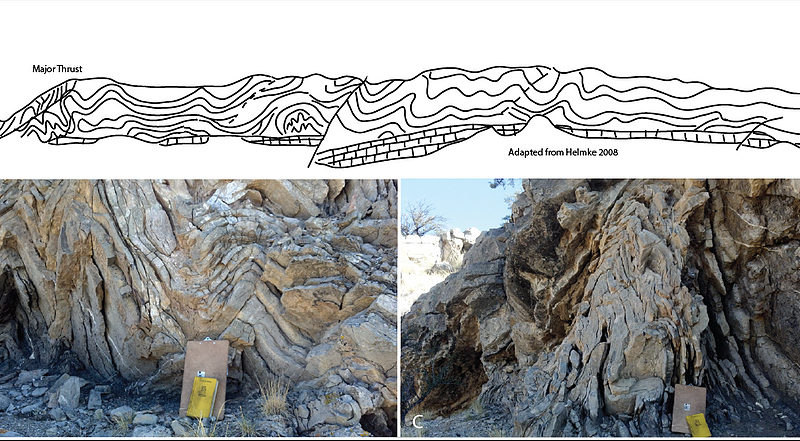

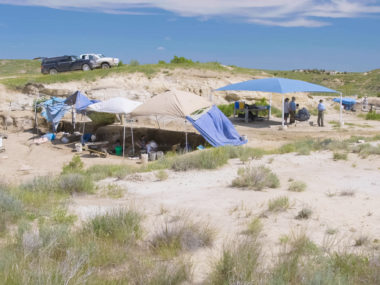
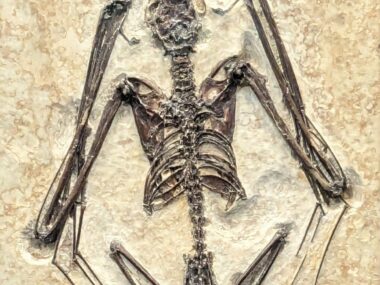

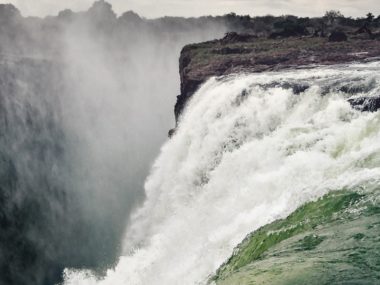
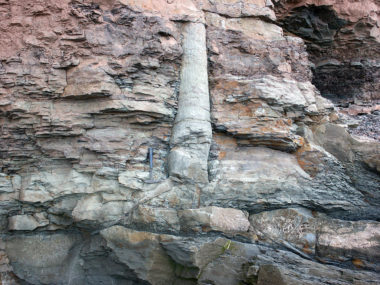




Indeed they can’t explain it because its a unique action from the flood year. it tore asunder everything. It divided the single continent. Yes I bet there are lots of places and mpre to be found where slow processes can’t explain the great results of power needed to manhandle sediment while its becoming rock.
Thanks Ken, great article! Takes me back to my geology field camp in the 80’s. I remember our professors sometimes offering vastly different scenarios to explain what we saw. On several different occasions I found fossils embedded in chronologically impossible formations (according to conventional thinking) and was told to ignore them . Anomalies!
Keep up the good work.
Nice detailed explanation of folded rock!